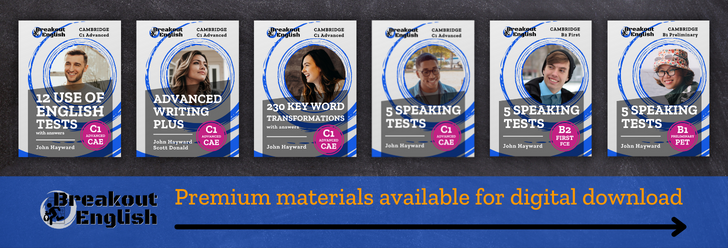Fixed expressions are a huge part of the Cambridge Advanced exam, coming into play far more frequently than in lower levels. The difficulty with CAE fixed expressions is that learners will often recognise them and understand them when seen in context. However, making them part of of their active vocabulary is a much greater challenge. For the CAE it is essential that your students know fixed expressions because they can and will come up in the open cloze (Part 2 of Use of English) and key-word transformations (Part 4 of Use of English). So let’s take a close look at what a CAE fixed expressions would be and how we can teach them.

If you are looking for transformations that use CAE fixed expressions, you can find them here:
Contents
What is a fixed expression?
A fixed expression is a combination of words which express an idea. It has taken on more meaning that the individual words while still maintaining a lexical connection. It is frequently used in certain circumstances to express a specific idea.
Examples include:
- My sister asked me to keep an eye on her kids while she was working late. (to watch / look after)
- It came as no surprise when Lawrence got the job. (it was expected / not surprising)
- It is only a matter of time until that bridge collapses. (it will happen at some point in the future)
- If she doesn’t start training, she won’t stand a chance of winning the race. (has no possibility)
As their name suggests, fixed expressions are fixed. This means the order and combination of words cannot be changed. The only flexibility in fixed expressions is a pronoun change (e.g. She made up her mind becomes I made up my mind) or a tense change (e.g. There is no point in arriving late becomes There was no point in arriving late).
What’s the difference between a fixed expression and an idiom?
Idioms use words that are completely removed from their lexical meaning. The meaning cannot be deduced from its individual words and it has a separate meaning of its own.
Examples include:
- My brother is a couch potato. (lazy)
- I can’t believe she let the cat out of the bag. (reveal a secret)
- Sarah’s new boyfriend really rubs me the wrong way. (annoy / bother)
- Losing the contract added insult to injury. (make a bad situation worse)
Idioms can be a lot of fun to teach and learn (idiom pictionary anyone?). Advanced students are often eager to scribble them down and bask in the glory of knowing something so obscure in their 2nd language. However, in my opinion, they are less useful for the CAE than their fixed expression counterparts.
How to teach fixed expressions
Unfortunately, unlike idioms, fixed expressions don’t lend themselves as easily to fun games and activities. You can’t describe, draw or act out by the time. So what we need to do as teachers is help our students notice fixed expressions when they see them. Encouraging noticing will create a deeper cognitive connection, which will help students take fixed expressions from their passive memory into active memory.
Here are some tips to make fixed expressions stick:
- Always look at fixed expressions as a whole and preferably in context.
- Whenever you do an exam task (or any task) that has fixed expressions, have your students write them down, think of a synonymous expression and write an example sentence. They can dedicate a section of their vocabulary notebook to this.
- Have students watch series and films and write down fixed expressions that they hear.
- Put fixed expressions on cards and have students think of sentences using them. Make it more fun by making the sentences true or false about them and their partner has to guess if it’s true or not.
- Give students fixed expressions that are gapped and they have to complete them.
- Create fixed expression pelmanism with synonymous phrases.
- Use materials like the ones on this page or this transformations activity which focus on fixed expressions.

The Materials
My preferred method of using these materials is by doing a dictogloss (procedure indicated below). However, they could also be used as is or adapted in other ways.
I suggest using these materials after you are sure that your students are familiar with the vast majority of the fixed expressions listed. There are a lot of CAE fixed expressions here which were found by searching through CAE exams and materials. Despite that, there are sure to be fixed expressions which appear in future exams which are not here, so don’t rely solely on this list.
If you are worried about the number of fixed expressions on this worksheet, I recommend cutting off the lower half of the page and focusing only on the fixed expressions that appear in the text.
EXAM PART: Use of English
EXAM SKILLS: Using a range of lexis appropriate to the level (C1)
TOPIC: Work
TIME: 60-90 minutes + homework/extension
PREPARATION: One copy of the worksheet per student
PROCEDURE WITH DICTOGLOSS:
- Introduce the topic of work by asking students a few discussion questions (e.g. When did you last have a job interview? Has anyone been fired from their job at the place where you work? What happened? etc.)
- Teacher reads the short text about work to the students, who just listen the first time.
- Students discuss what the text was about in general.
- Teacher reads the text again and students take notes of key words. Point out that they should not try to write down every word.
- Students work together to reconstruct the text. Teacher can read the text again if necessary.
- When finished, hand out the worksheet with the original text and students compare with their reconstructions.
- Students discuss the meaning of the fixed expressions in the text.
- Students examine the list of CAE fixed expressions and discuss any which are new for them.
- Students work together to create their own short text on the topic of work with CAE fixed expressions from the list (could be done as homework).
- EXTENSION: Students read their texts to others who listen and discuss what it is about.
Download



